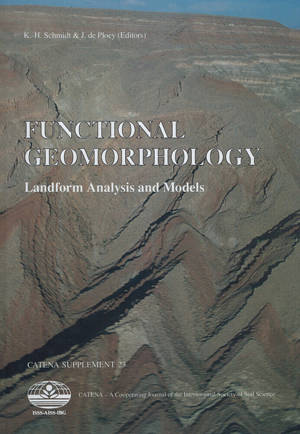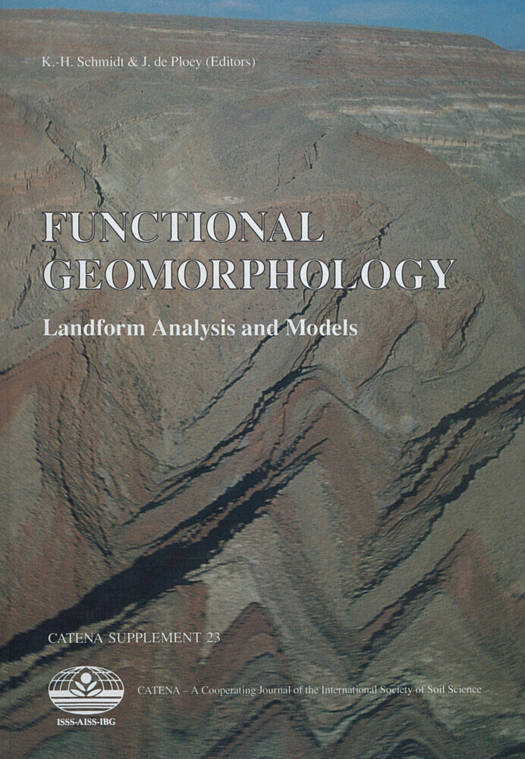
- Retrait gratuit dans votre magasin Club
- 7.000.000 titres dans notre catalogue
- Payer en toute sécurité
- Toujours un magasin près de chez vous
- Retrait gratuit dans votre magasin Club
- 7.000.0000 titres dans notre catalogue
- Payer en toute sécurité
- Toujours un magasin près de chez vous
Description
The papers of the Festschrift either follow lines of research in landform analysis and modelling that have attracted Frank Ahnert s interest (papers 1-6) or are directly related to his work (papers 7-11). There are two soil erosion studies, one concerning the short-term evolution of gully microsteps and scour channels (Bryan & Oostwood-Wijdenes), the other the long-term formation of badlands using a well established erosional susceptibility model (De Ploey). Yair addresses the effects of climatic change at the desert fringe and shows that depending on internal system conditions a wetter climate does not necessarily cause a more humid local environment. In a methodological study Jungerius and Schoonderbeek investigate blowout development in coastal dunes. Both in empirical and modelling approaches badland slope profile evolution has almost exclusively been studied without considering the formative importance of mass movements. De Lugt & Campbell draw the attention to the role of mass movement processes in slope development in one of the most thoroughly investigated badland areas, the Dinosaur Provincial Park in Alberta. Most research in fluvial geomorphology has been focussed on alluvial channels. Little is known about the processes of channel incision into bedrock. In their study Seidl & Dietrich put the emphasis on vertical erosion by streamflow and abrasion, debris flow scour and knickpoint recession in bedrock channels. The first paper directly referring to Frank Ahnert s work is Olav Slaymaker s attempt to reconcile Ahnert s process-response models with a sediment storage approach based on empirical findings from the Canadian Cordillera. It becomes clear that Ahnert has never attempted to model fluvial systems with a disequilibrium state caused by a glacial or other non-fluvial heritage and has never emphasized examples where large-scale alluvial storage is important. Choosing the example of the classic geomorphological study area of the Henry Mountains in Utah, Schmidt s contribution tries to demonstrate that, using the terminology of Frank Ahnert s 1988-paper on landform change, no eksystemic variations of climate or tectonism are needed to effect changes in system conditions. Ensystemic attributes alone can control changing equilibrium states. It is shown that Gilbert s dynamic equilibrium concept helps to explain complex evolutionary aspects in historical geomorphology. Also in Ergenzinger & Schmidt s paper the ensystemic character of landform change is emphasized. A soil erosion model, originally designed to determine soil erosion budgets in response to short-term events, is used to simulate long-term slope evolution. This idea was inspired by Frank Ahnert s 1987-statement that process-response models yield valid results of denudation regardless of the time scale involved. Kirkby presents an erosion-limited hillslope evolution model as a generalization for both transport and supply limited conditions. A wide range of processes is represented in the model with the possibility of distinction between rainsplash, rainflow and rillwash. Cox refers to Frank Ahnert s magnitude-frequency morphoclimatic concept. He questions whether gamma distributions, recently much applied to hydro-geomorphological problems, may not be more suitable for describing the distributions of empirical precipitation data.
Spécifications
Parties prenantes
- Editeur:
Contenu
- Nombre de pages :
- 212
- Langue:
- Anglais
- Collection :
- Tome:
- n° 23
Caractéristiques
- EAN:
- 9783510653645
- Format:
- Livre relié
- Dimensions :
- 170 mm x 240 mm
- Poids :
- 520 g

Les avis
Nous publions uniquement les avis qui respectent les conditions requises. Consultez nos conditions pour les avis.





